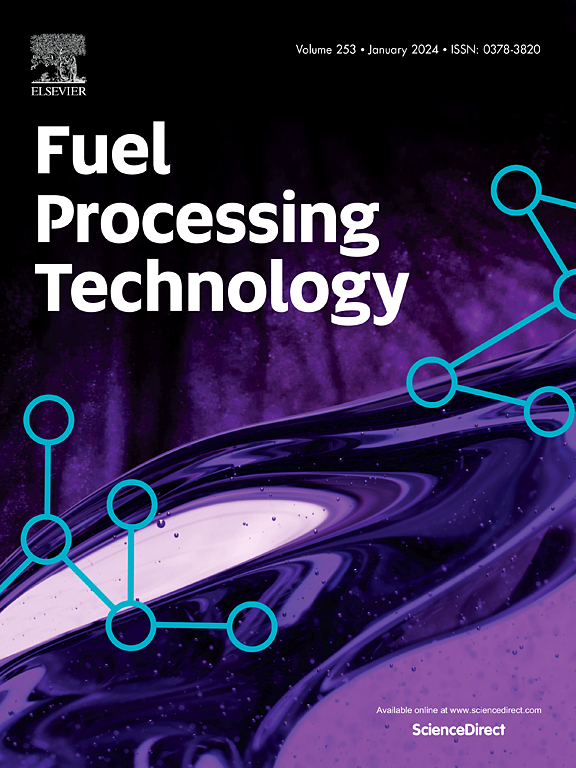Structural evolution characteristics of sulfur in coal during gold-tube thermal simulation
IF 7.2
2区 工程技术
Q1 CHEMISTRY, APPLIED
引用次数: 0
Abstract
This study used a gold tube thermal simulation experiment to investigate the release of gases, the formation of free sulfur-containing compounds, and the evolution of coal macromolecules and organic sulfur structures. Results indicate that at Easy%Ro = 0.71, the drying coefficient (C1/ΣC1–5) of high-organic‑sulfur coal is significantly higher than that of low-organic‑sulfur coal. When Easy%Ro ≥ 3.64, the organic sulfur content in coal significantly promotes methane generation. At Easy%Ro = 1.75, small molecules of free organic sulfur are most abundant in coal. At Easy%Ro ≥ 3.64, low and high-organic‑sulfur coals produce elemental sulfur S8 and ester sulfate compounds. FTIR analysis reveals that high-organic‑sulfur coal contains more aliphatic hydrocarbon structures, resulting in lower aromaticity parameter I than low-organic‑sulfur coal at the same coalification level. In contrast, the hydrocarbon generation potential factor “A” is higher, indicating that organic sulfur inhibits coal aromatization, and high-organic‑sulfur coal has a higher hydrocarbon generation potential. XPS analysis shows that thiophene and sulfoxide are relatively more abundant in high-organic‑sulfur coal, with the highest reaching 91.24 % in SHOS coal. The aromaticity of organic sulfur rapidly increases when Easy%Ro < 1.75, followed by possible inhibition of thiophenic sulfur production by sulfones and sulfoxides in coal, resulting in decreased aromaticity.
金管热模拟中煤中硫的结构演化特征
本研究采用金管热模拟实验研究了气体的释放、游离含硫化合物的形成以及煤大分子和有机硫结构的演化。结果表明,在Easy%Ro = 0.71时,高有机硫煤的干燥系数(C1/ ΣC1-5)显著高于低有机硫煤。Easy%Ro≥3.64时,煤中有机硫含量显著促进甲烷生成。在Easy%Ro = 1.75时,煤中游离有机硫的小分子最为丰富。Easy%Ro≥3.64时,低、高有机硫煤产生单质硫S8和酯硫酸盐化合物。FTIR分析表明,在相同煤化水平下,高有机硫煤含有更多的脂肪烃结构,导致其芳香性参数I低于低有机硫煤。而生烃潜力因子A较高,说明有机硫抑制了煤的芳构化,高有机硫煤具有较高的生烃潜力。XPS分析表明,高有机硫煤中噻吩和亚砜含量相对较高,其中SHOS煤含量最高,达91.24%。当Easy%Ro <;1.75,其次是煤中的砜和亚砜可能抑制噻吩硫的产生,导致芳香性降低。
本文章由计算机程序翻译,如有差异,请以英文原文为准。
求助全文
约1分钟内获得全文
求助全文
来源期刊

Fuel Processing Technology
工程技术-工程:化工
CiteScore
13.20
自引率
9.30%
发文量
398
审稿时长
26 days
期刊介绍:
Fuel Processing Technology (FPT) deals with the scientific and technological aspects of converting fossil and renewable resources to clean fuels, value-added chemicals, fuel-related advanced carbon materials and by-products. In addition to the traditional non-nuclear fossil fuels, biomass and wastes, papers on the integration of renewables such as solar and wind energy and energy storage into the fuel processing processes, as well as papers on the production and conversion of non-carbon-containing fuels such as hydrogen and ammonia, are also welcome. While chemical conversion is emphasized, papers on advanced physical conversion processes are also considered for publication in FPT. Papers on the fundamental aspects of fuel structure and properties will also be considered.
 求助内容:
求助内容: 应助结果提醒方式:
应助结果提醒方式:


